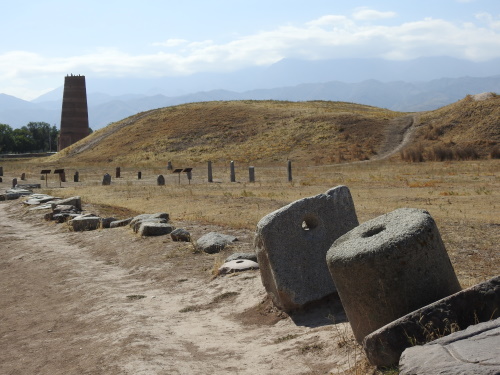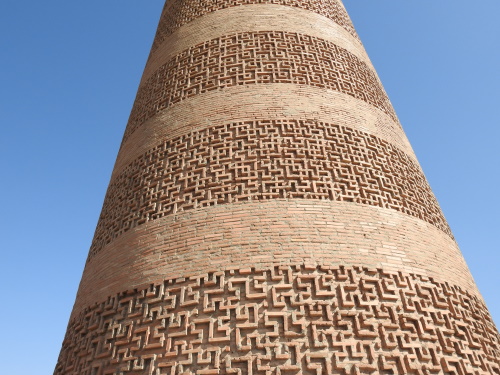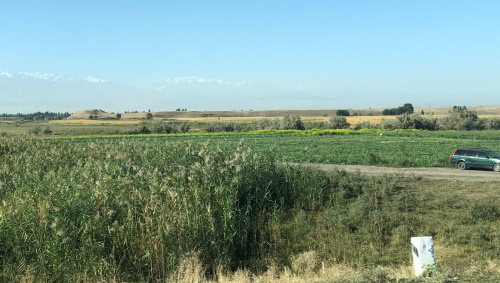Blog WHS Visits
Silk Roads: Zhetysu region
The Silk Roads do have the potential to blow away the Roman Limes regarding the number of separate nominations: no less than 54 corridors have been distinguished in the ICOMOS Thematic Study. Fortunately, they are meant to be combined and some will never be put forward. So far only 1 has made it: the Tian-shan Corridor, shared by China, Kazakhstan, and the Kyrgyz Republic. It spans 5,000 km and is further split into 4 sections. The first section in Central China can be considered the starting point of all Silk Routes. In 2007 I already visited a number of locations in this section (Xian’s Wild Goose Pagodas, Longmen Grottoes) and in the second one named Hosi Corridor (Mogao Caves, Yumen Pass). In this review, I will focus on the fourth section, known as the Zhetysu region, at the other end of this particular Silk Road. I went there in September 2021.
Zhetysu is the historical name for parts of Kazakhstan and Kyrgyzstan. Meaning “seven rivers”, it comprises the fertile grasslands between Lake Balkhash and Lake Issyk Kul. It is where nomadic people settled, built fortified sites, and turned to agriculture and trade. These inhabitants of Central Asia traded mainly in horses, jewelry, fruit, and nuts with the Chinese.
In this region, Kyrgyzstan contributes 3 sites to the serial nomination. The one with the most visible remains is the archaeological site of Balasagun (nowadays called Burana). This flatland is still a fertile agricultural area. Judging by what is being offered for sale on the streets, they mainly grow maize and melons.
At Burana, I was the first visitor of the day, the female caretaker opened up the museum for me. It has only one exhibition room, but you can see the variety of materials that the Silk Road brought here. There are coins, shells that served as currency, an earthenware chest in which bones of a deceased were kept (ossuary), remains of a Buddha statue, and tombstones with inscriptions in different languages.
Its main attraction is a minaret originating from the late 10th century. It has been tinkered with a lot during the centuries afterward – as the region is prone to earthquakes. The stone staircase in the interior of the tower is probably the most original element, in addition to some fine Square Kufic higher up. You get in nowadays via climbing an iron staircase attached to the outside, I wonder how they did it in medieval times? Maybe there was a wooden staircase. This picture from the early 20th century shows how it looked like before renovations.
Other elements of the former city can still be recognized in the terrain. The large hill next to the tower covers the remains of a palace. An earthen wall still surrounds most of the site. The outlines of three mausoleums, containing the tombs of the rulers of the empire of which Balasagun was the capital, have been reconstructed. Many excavations were done here in the 20th century, but almost everything has been covered with earth again because there were no other options to preserve it.
A large part of the site is now arranged as a kind of sculpture garden displaying findings from the wider area. Here stand and lie tombstones on which people are depicted (balbals), ceramic pipes that were used for irrigating farmland, and millstones.
I had also wanted to visit a second location in Kyrgyzstan, Nevakat, which lies just outside the modern village of Krasnaya Rechka. Marshrutkas between Bishkek and Tokmok, the closest sizeable town to Burana, seem to pass it – but in reality “passing” indeed is what they do, there is no access from the northernmost road along the border with Kazakhstan which the drivers prefer. When you look out of the window to the right, the huge earthen walled enclosure is visible (see 3rd photo). To visit, it would be best to arrange something with the taxi driver that also has taken you to Burana. Ruins of Buddhist temples have been found at Nevakat, as well as a Karakhanid palace complex, and Nestorian-Christian cemeteries. There have been plans for a long time to develop this site for tourism as well, but it is unclear what the status is at the moment.
Els - 19 September 2021


